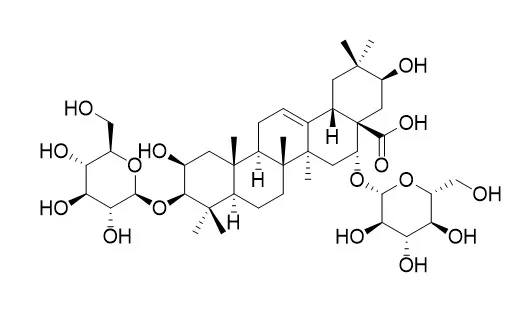| Structure Identification: |
| Chinese Medicine, 2016, 11(1):32. | | Influence of sulfur fumigation on glycoside profile in Platycodonis Radix (Jiegeng).[Reference: WebLink] | Over recent decades, sulfur fumigation is becoming abused in processing some freshly harvested herbs used as both medicine and food, although it has been questioned whether sulfur fumigation will change the efficacy and safety of the herbs. One of the herbs commonly processed by sulfur fumigation is Platycodonis Radix (Jiegeng in Chinese). Glycosides are the main bioactive components of Jiegeng. Up to the present, no study has been carried out to evaluate the impact of sulfur fumigation on glycoside profile of Jiegeng.
METHODS AND RESULTS:
A rapid and versatile ultra-high performance liquid chromatography coupled with ultra-high resolution quadrupole time-of-flight mass spectrometry (UHPLC UHD Q-TOF MS/MS) method was developed for comprehensive analysis of the glycoside profiles of sulfur-fumigated and air-dried Jiegeng samples.
Twenty-three glycosides were detected in air-dried and sulfur-fumigated Jiegeng samples. After sulfur fumigation, the peak heights of eight glycosides, namely Platycogenin A, platycodin D, platycodin D2, platycodin D3, polygalacin D, polygalacin D2, deapio-platycodin D and 3″-O-acetylplatycodin D2, remarkably decreased; while peak heights of five glycosides, namely syringin, lobetyolin, platycoside E, deapio-platycodin D2 and deapio-platycoside E, slightly increased; in addition, peaks of ten glycosides, platycodin A, platycodin C, platycodin V, platycoside C, 16-oxoplatycodin D, 2″-O-acetylpolygalacin D, 2″-O-acetylpolygalacin D2, 3″-O-acetylpolygalacin D, 3″-O-acetylpolygalacin D2, and platycogenic acid B, disappeared.
CONCLUSIONS:
Sulfur fumigation caused significant changes of glycoside components of Jiegeng. Further investigations are warranted to explore how these chemical changes occurred and whether these changes would affect the efficacy and safety of Jiegeng. |
|






 Cell. 2018 Jan 11;172(1-2):249-261.e12. doi: 10.1016/j.cell.2017.12.019.IF=36.216(2019)
Cell. 2018 Jan 11;172(1-2):249-261.e12. doi: 10.1016/j.cell.2017.12.019.IF=36.216(2019) Cell Metab. 2020 Mar 3;31(3):534-548.e5. doi: 10.1016/j.cmet.2020.01.002.IF=22.415(2019)
Cell Metab. 2020 Mar 3;31(3):534-548.e5. doi: 10.1016/j.cmet.2020.01.002.IF=22.415(2019) Mol Cell. 2017 Nov 16;68(4):673-685.e6. doi: 10.1016/j.molcel.2017.10.022.IF=14.548(2019)
Mol Cell. 2017 Nov 16;68(4):673-685.e6. doi: 10.1016/j.molcel.2017.10.022.IF=14.548(2019)